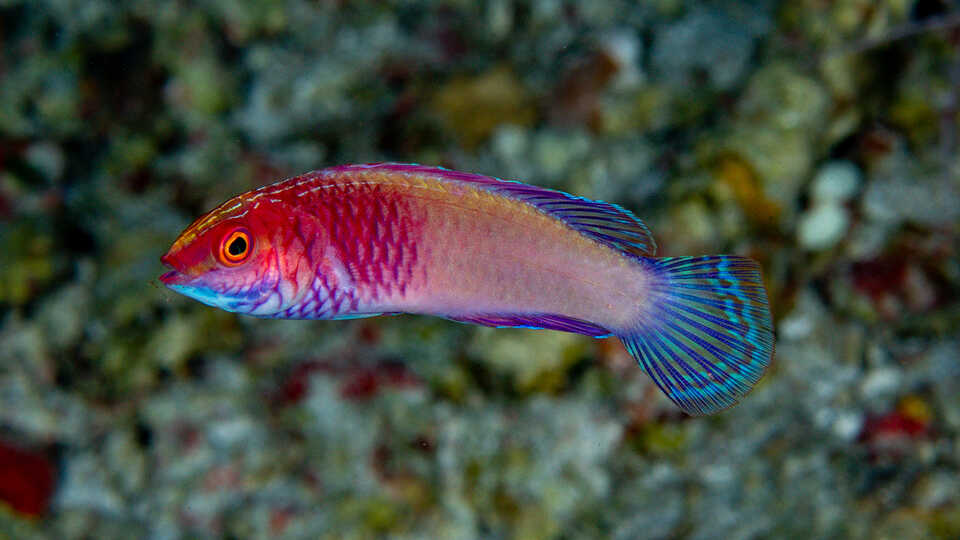Scientists discover beautiful new rainbow-colored fish lurking among 'twilight reefs'
The newly named wrasse was previously mislabeled as another species.

Researchers have described a stunning multicolored wrasse in the Maldives as a newfound species, after the fish spent decades being misidentified as a closely related species. The rainbow-colored fish lives among unusually deep coral reefs known as "twilight reefs."
The newly described species, which has been named the rose-veiled fairy wrasse (Cirrhilabrus finifenmaa), resembles the red velvet fairy wrasse (Cirrhilabrus rubrisquamis), which is found across the western Indian Ocean. Both species live on mesophotic coral reefs, which grow much deeper than most tropical coral reefs — between 100 and 490 feet (30 and 149 meters) below the ocean’s surface, according to the National Oceanic and Atmospheric Administration. Scientists collected the first C. finifenmaa specimen in 1990, but its similarity to C. rubrisquamis meant that experts didn't recognize the fish as a distinct species.
Recently, after noticing this mistake, another group of researchers collected specimens of C. finifenmaa from the twilight reefs surrounding the Maldives. When they compared the new specimens to C. rubrisquamis wrasses, they found that C. finifenmaa females (which are mainly red, pink and blue) were a close match to C. rubrisquamis. However, C. finifenmaa males were not; their scales featured more orange and yellow hues. The researchers also found that C. finifenmaa has a different number of scales in certain body regions and taller dorsal spines than its look-alike cousin. DNA analysis confirmed that these two species were genetically distinct.
In addition, the study revealed that C. finifenmaa has a much smaller geographic range than C. rubrisquamis, which will inform conservation efforts to protect the species.
Related: 11 strange things that washed ashore in 2021
"What we previously thought was one widespread species of fish is actually two different species, each with a potentially much more restricted distribution," lead author Yi-Kai Tea, a doctoral student at the University of Sydney in Australia, said in a statement. "This exemplifies why describing new species, and taxonomy in general, is important for conservation and biodiversity management."
During the survey, the researchers also collected specimens from eight more newly discovered species that are still waiting to be described, according to the statement.
Sign up for the Live Science daily newsletter now
Get the world’s most fascinating discoveries delivered straight to your inbox.

The species name "finifenmaa means "rose" in the Maldives' Indigenous Dhivehi language, referencing not only the beautiful pink and red colors displayed by the new species but also the Maldives' national flower. This marks the first time that a Maldivian researcher has chosen the scientific name of a local fish species, despite the island chain being home to around 1,100 fish species, according to study co-author Ahmed Najeeb, a biologist at the Maldives Marine Research Institute.
"It has always been foreign scientists who have described species found in the Maldives, without much involvement from local scientists," Najeeb said in the statement. "This time it is different, and getting to be part of something for the first time has been really exciting."
However, the researchers suspect that the Maldives' C. finifenmaa population may be in danger of declining. C. rubrisquamis wrasses have long been targeted by local fishers to be sold for the global aquarium trade, which generates around $330 million each year, according to the United Nations Environment Programme. Because the two wrasse species look so much alike, C. finifenmaa may also be affected by such activities, according to the statement.
"Though the species is quite abundant and, therefore, not currently at a high risk of overexploitation, it's still unsettling when a fish is already being commercialized before it even has a scientific name," study co-author Luiz Rocha, an ichthyology curator at the California Academy of Sciences in San Francisco, said in the statement.
The study was published online March 8 in the journal ZooKeys.
Originally published on Live Science.

Harry is a U.K.-based senior staff writer at Live Science. He studied marine biology at the University of Exeter before training to become a journalist. He covers a wide range of topics including space exploration, planetary science, space weather, climate change, animal behavior and paleontology. His recent work on the solar maximum won "best space submission" at the 2024 Aerospace Media Awards and was shortlisted in the "top scoop" category at the NCTJ Awards for Excellence in 2023. He also writes Live Science's weekly Earth from space series.










